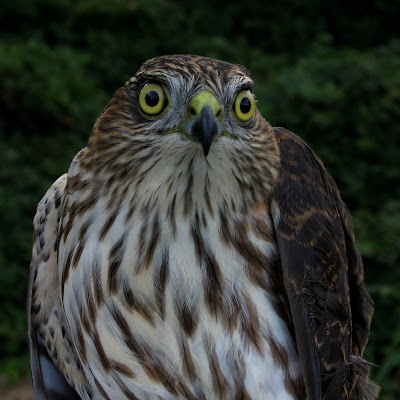Readers who have been following this blog for a while may remember that I spent last fall living in Cape May and learning to band raptors with the Cape May Raptor Banding Project. Last week my friend Bob invited me to assist with banding at his blind for the week. I was happy to go because it was a great chance to reconnect with old friends and meet some new people associated with the project.
Of course, raptor banding is also an opportunity to see some great birds at close range. My Twitter followers may already know about one of them: early on Monday morning a Great Blue Heron crashed into one of the mist nets and got caught. Unfortunately I do not have photos; I was just happy to extract it without getting my eyes or stomach gouged. Other non-raptors included a Yellow-billed Cuckoo and a Brown Thrasher. There was not much of a raptor flight on Monday or Tuesday, but migration picked up later in the week. Thursday was particularly favorable for banding.
At Cape May, the bread-and-butter raptor for banders is the Cooper's Hawk. Observers on the Cape May Point dune line, such as the CMBO hawkwatch, generally report more Sharp-shinned Hawks than Cooper's Hawks. Banding stations, located a little more inland, have reported the opposite distribution in recent years. We banded this immature Cooper's Hawk on Tuesday.
Sharp-shinned Hawks are plentiful around the banding stations. As with Cooper's Hawks, Sharp-shinned Hawks are accipiters, hawks with short wings and long tails that primarily eat smaller birds. We banded this immature Sharp-shinned Hawk on Wednesday.
Likewise, Red-tailed Hawks are common around the Cape May banding stations, though most of them arrive during the month of November. Most of the raptors banded at Cape May are immature, as immature raptors migrate along the coast while adult raptors tend to follow interior routes. There is probably also an element of experience since adult birds may be more likely to recognize the nets in time to avoid them. We banded this immature Red-tailed Hawk on Wednesday.
While those three species represent the most frequently banded raptors in Cape May, I usually think of the peninsula more for the abundance of falcons there. Unlike other raptors, which depend on thermals and updrafts, falcons can migrate long distances over water and frequently do if it means traveling a shorter distance. Thus they tend to be common around coastal hotspots when they come in to rest and hunt.
Merlins are small, hyperactive falcons that blast around the dunes and meadows, especially at dawn and dusk. In the hand, they squirm and flap and kick and bite and scream from the moment they land in a net to the moment of their release. This immature Merlin was banded on Tuesday.
Finally, one of my favorite Cape May raptor species is the Peregrine Falcon. Last year, I was impressed by how well Peregrines handled bad weather. Even under the windiest conditions, these falcons seemed unaffected while other raptors were getting blown away. Like Merlins, Peregrines can be high-strung and uncooperative in the hand. This bird, which we banded on Monday, was relatively docile.
Overall the banding project seems to be doing better this year compared to last season. As of the end of the previous week, the number of banded raptors was about 100 birds ahead of an equivalent point in 2008. That bodes very well for the rest of the season. Last year was the worst in about a decade due to persistently unfavorable weather patterns. I am happy that the banders this year are not having as hard of a time.








